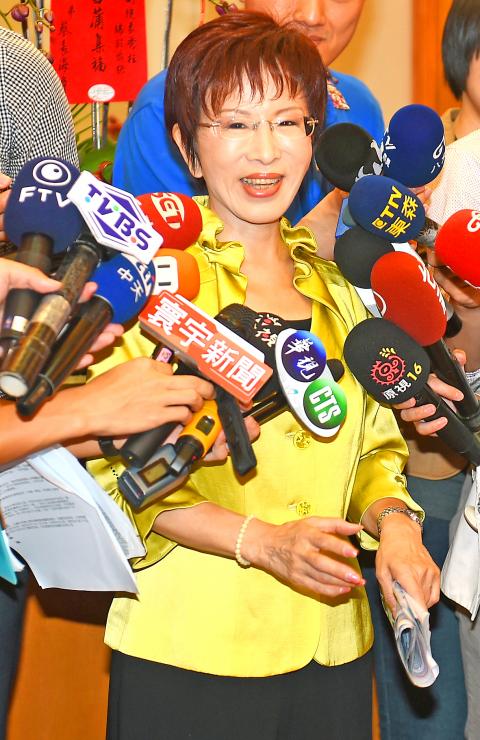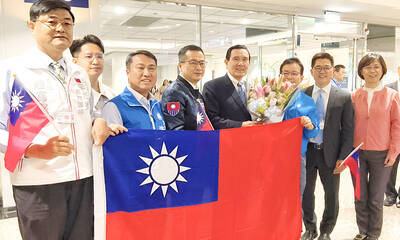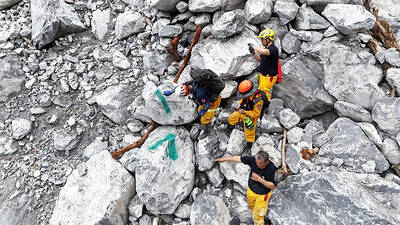The Republic of China (ROC) Constitution allows no possibility of Taiwanese independence, Chinese Nationalist Party (KMT) presidential hopeful Hung Hsiu-chu (洪秀柱) said yesterday, when asked whether she would take a more radical approach to pushing for cross-strait unification.
“You can look at the ROC Constitution. Does it allow for Taiwanese independence?” the deputy legislative speaker told reporters, when she was asked for her views on media commentaries that said she would accelerate the process of unification if she wins the presidential election in January.
Cross-strait policy under any administration must respect the Constitution, Hung said, adding that even Democratic Progressive Party (DPP) Chairperson and presidential candidate Tsai Ing-wen (蔡英文) said in a speech at the Center for Strategic and International Studies in Washington earlier this month that she would handle cross-strait relations in accordance with the ROC Constitution.

Photo: Chang Chia-ming, Taipei Times
The beginning of the Additional Article of the Constitution states that any articles that are added to or amended in the Constitution are to “meet the requisites of the nation prior to national unification,” Hung said.
That clearly shows the ROC Constitution is based on the “one China” principle, she added.
Hung said that what worries Taiwanese is the prospect of unification taking place on China’s terms, because China wishes to apply its “one country, two systems” formula in the unification of Taiwan, while Taiwan wants to see a unified China characterized by freedom, democracy and the rule of law.
Hung again pledged to sign a peace treaty with China if she is elected president, saying the idea had been proposed in the past by former presidents Lee Teng-hui (李登輝) and Chen Shui-bian (陳水扁) as well as President Ma Ying-jeou (馬英九). She added that Tsai helped formulate Chen’s proposal when she served as Mainland Affairs Council minister.
“I did not invent the idea. They did not follow through with it, probably because it aroused some suspicion among the public, but if the idea is in the interests of Taiwan, we should make it clear to the public,” Hung said.
She added that signing a cross-strait peace treaty is consistent with the so-called “1992 consensus,” referring to a tacit understanding between the KMT and the Chinese government that both sides of the Taiwan Strait acknowledge there is “one China,” with each side having its own interpretation of what “China” means.
“There is no difference between the two. What we need to think about is whether we should take a step further into the ‘deep-water zone’ beyond the ‘1992 consensus’ and whether we should try to make a breakthrough in cross-strait relations or whether we would rather stay where we are now,” Hung said.

Former president Ma Ying-jeou’s (馬英九) mention of Taiwan’s official name during a meeting with Chinese President Xi Jinping (習近平) on Wednesday was likely a deliberate political play, academics said. “As I see it, it was intentional,” National Chengchi University Graduate Institute of East Asian Studies professor Wang Hsin-hsien (王信賢) said of Ma’s initial use of the “Republic of China” (ROC) to refer to the wider concept of “the Chinese nation.” Ma quickly corrected himself, and his office later described his use of the two similar-sounding yet politically distinct terms as “purely a gaffe.” Given Ma was reading from a script, the supposed slipup

Former Czech Republic-based Taiwanese researcher Cheng Yu-chin (鄭宇欽) has been sentenced to seven years in prison on espionage-related charges, China’s Ministry of State Security announced yesterday. China said Cheng was a spy for Taiwan who “masqueraded as a professor” and that he was previously an assistant to former Cabinet secretary-general Cho Jung-tai (卓榮泰). President-elect William Lai (賴清德) on Wednesday last week announced Cho would be his premier when Lai is inaugurated next month. Today is China’s “National Security Education Day.” The Chinese ministry yesterday released a video online showing arrests over the past 10 years of people alleged to be

The bodies of two individuals were recovered and three additional bodies were discovered on the Shakadang Trail (砂卡礑) in Taroko National Park, eight days after the devastating earthquake in Hualien County, search-and-rescue personnel said. The rescuers reported that they retrieved the bodies of a man and a girl, suspected to be the father and daughter from the Yu (游) family, 500m from the entrance of the trail on Wednesday. The rescue team added that despite the discovery of the two bodies on Friday last week, they had been unable to retrieve them until Wednesday due to the heavy equipment needed to lift

THE HAWAII FACTOR: While a 1965 opinion said an attack on Hawaii would not trigger Article 5, the text of the treaty suggests the state is covered, the report says NATO could be drawn into a conflict in the Taiwan Strait if Chinese forces attacked the US mainland or Hawaii, a NATO Defense College report published on Monday says. The report, written by James Lee, an assistant research fellow at Academia Sinica’s Institute of European and American Studies, states that under certain conditions a Taiwan contingency could trigger Article 5 of NATO, under which an attack against any member of the alliance is considered an attack against all members, necessitating a response. Article 6 of the North Atlantic Treaty specifies that an armed attack in the territory of any member in Europe,